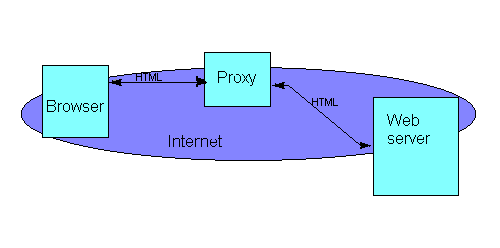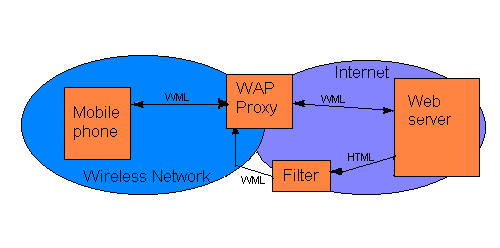·Introduction to WAP
·WAP for Developers
·WAP and Content Providers
·Adding WAP to the Internet
·WAP and Internet standards
·WAP and ISP
·References
Authors:
Patrik Backlund
Developers
Jon Sundwall
Content Providers
Anette Bernas
WAP and Internet
Adding WAP to the Internet
Simplified, this is what the Internet architecture looks like today:

In a network connected to the Internet, a proxy server is associated with a gateway server that separates the network from the Internet. The proxy server acts as an intermediary between a Web surfer and a Web server, receiving and forwarding traffic between these.
Web pages are stored on WWW servers. The servers use HTTP to send the HTML pages to the users. Enterprises, companies, universities etc. often have their own WWW servers, whereas individual users usually get acces to the Internet through an Internet Service Provider.
When a user wants to download a Web page, the proxy server receives a request to download the page from the user. The proxy server, acting as a client on behalf of the user, requests the page from the WWW server. When the page is returned, the proxy server relates it to the original request, and forwards the page on to the user.
The proxy server can also function as a cache server. In this case the proxy server keeps a copy of the returned web page in its cache. When the proxy receives a request from a user to download a page, it first looks in its cache of previously downloaded pages. If the page is in the cache, the proxy server returns the page to the user without forwarding the request to the Internet server. The cache service serves all users. If one or more Internet sites are frequently requested, these are likely to be in the proxy's cache, something that will improve user response time.
Adding the WAP scenario to the picture would make it look something like this:

In a wireless network that is connected to the Internet, there is a WAP proxy server associated with the gateway that connects the wireless network to the Internet. The WAP proxy server receives and forwards traffic between a mobile Web surfer and a WWW server on the Internet in the same way as a proxy server.
The Web pages stored at the WWW server are written in HTML. The Web server can also store WAP content, WML. The way the files (HTML pages or WML blocks) are retrieved from the Web server is similar. It is not necessary to write WML versions of already existing HTML pages. By using a filter HTML pages can be modified into WML pages. The filter "translates" HTML to WML.